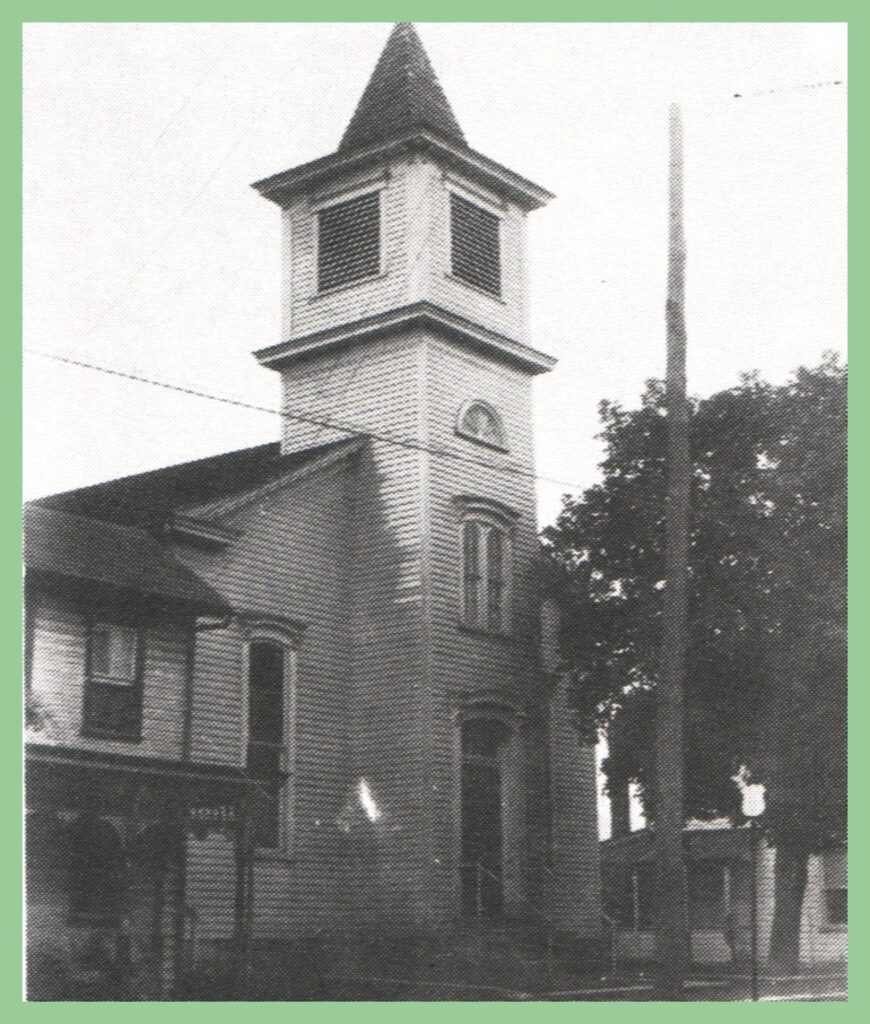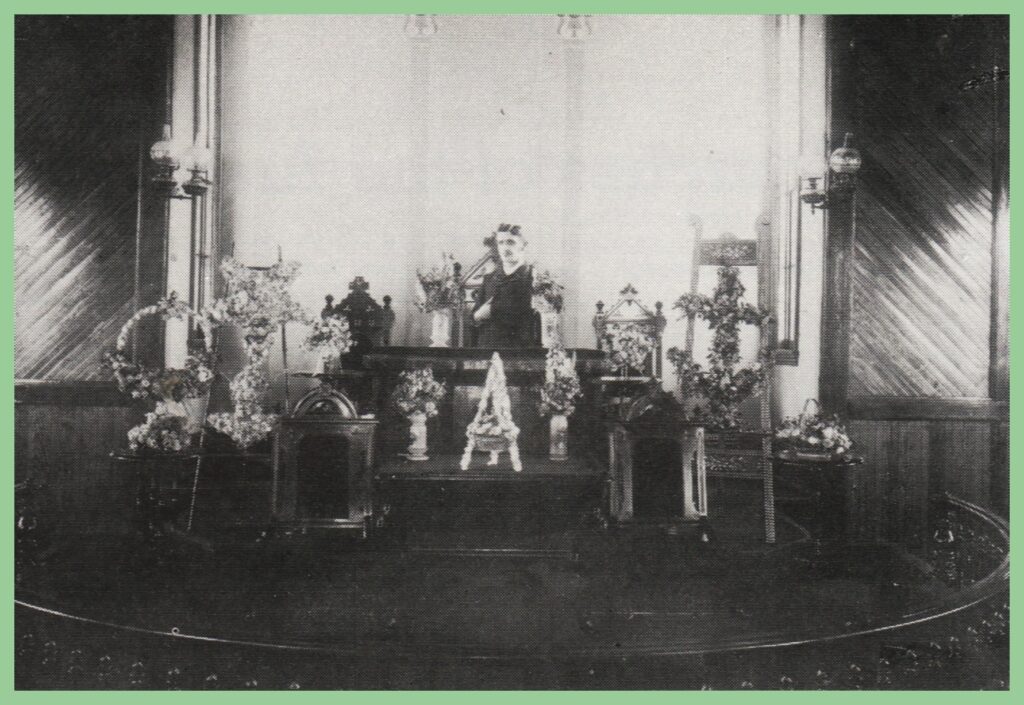A history of the Seybert Evangelical Church of Williamstown, Dauphin County, Pennsylvania, from its conception in 1826, through the construction of the first church building in Williamstown in 1871, through its sale for use as a grocery store in 1973. This history and the accompanying photographs are from the Sesquicentennial History of Williamstown and Williams Township, Dauphin County, Pennsylvania, published in 1976. For availability of copies of this book, contact the Williamstown and Williams Township Historical Society, 115 W. Market Street, Williamstown, Pennsylvania 17098.
Above, an undated photograph of the Seybert Evangelical Church.
_____________________________________________________________
A History of Seybert Evangelical Church, 1826-1976
A rugged farming and coal mining region in Upper Dauphin County, the Lykens and Williams Valleys were first introduced to the Evangelical witness when John Seybert held evangelistic services in Lykens in 1826. At first these people were difficult to reach with the Gospel, and it has been said during this campaign, Brother Seybert “subjected himself to great persecution.” However, his preaching resulted in the awakening of many sinners to their need of salvation.
These first beginnings succeeded in opening the way for the evangelical Association and before long stations were placed in the Lykens and Mahantongo Valleys. During the 1850’s, the Berrysburg Circuit was established and in 1867, through the interests of the “Williamstown citizenry” and outside members from Lykens and Williamstown, a Union Sunday School was established in the old “West End” school house, which was later destroyed by fire. The first Sunday School session was conducted in the fall of 1867 in the school house. It was a union of all denominations. When the time for the session arrived, the Superintendent, J. W. Durbin, delayed the opening service. Albany Chester, secretary of the school, reminded him time was passing. Neither of these men was a member of the church. They discovered that no one present could make the opening prayer. Mr. Chester suggested they start the services, and perhaps the Lord would send someone to do the praying. Halfway through the first hymn, J. H. Carl, the treasurer, entered. Everyone smiles and called upon him to pray. Pray he did – in German. Mr. Carl was a member of the Association. Mr. Durbin and Mr. Chester later became members of the Methodist Church, which was formed later.
At the conference in 1869, it was noted by Rev. R. Dreibelbis, then pastor of the Berrysburg Circuit, that a group of evangelically minded people in Williamstown had purchased a piece of property for the erection of a church building. At the thirteenth annual conference of the Evangelical Assosicaiton, it was announced that Williamstown would build a church. This was the very first worship sanctuary to be erected in all of Williamstown. In the Dauphin County Historical record of 1883 it noted: The Evangelical Association erected the first church, which was built in 1869 and 1870, and on December 29, 1870, the congregation was incorporated. It was first a part of the Berrysburg Circuit, then made the “Williamstown Circuit,” out of which Lykens had since been removed. Before the erection of the church edifice, preaching was held in the school house.
The piece of ground upon which the church was erected was situared on the southeast corner of Grant Street and Pottsville Street (later changed to market Street). The deed to the land was finally acquired from Henry Workman for the sum of $200.00. The deed was dated November 1, 1870. According to some records, the church as built by the time the deed was recorded and paid for by the association.
On February 22, 1871, the “Williams Valley Mission” became a reality and Rev. R. Dreibelbis was assigned as the first pastor. In the light of the mission work of Bishop Seybert, the first church of Williamstown was named in his honor, and the building maintained that name until it was sold to Ward Unholtz and Edith Umholtz for use of a grocery store in 1973.
The church progressed rapidly, and in 1880 a parsonage was purchased. This parsonage is said to be the present site of George Adams‘ and Laverne Adams‘ home, located on the corner of Julian Street and Grant Street.
The church continued to grow. After the church was opened, the Methodist and the United Brethren both worshipped here until their churches were erected. Each of these churches paid one dollar a week for rent for their services. During the 1880s, the Sunday School and church grew with a membership of well over 200 in 1890. However, in 1890-91, a number of problems spread throughout the denomination and brought a split in the Seybert Church. Bitter and heated arguments ensued, and the majority finally issued an ultimatum to the minority that they either drop their complaints or leave. the minority chose the latter alternative and left.
The newly-formed group continued to meet and hold their trustee meetings in the basement of the Seybert Church until November 1894, when they finally left the church after much pressure from the majority of the members. They continued to worship at the Primitive Methodist on Broad Street.
The greatest growth of the Seybert Church came during the pastorate of D. H. Newhart. The Rev. James Shoop followed him in 1890, but when the split came in 1891-92, he sided with the minority and became their pastor. D. S. Manning followed Shoop as pastor when he left in 1892.
In 1920 when the Tower City Evangelical caught on fire, all of Seybert’s church records were burned, since all their records were housed in the Tower City church. From 1920 the church’s history is therefore vague. Some names of pastors have been available, but other pertinent data are not available. From 1920 many improvements and changes have taken place. New aluminum siding was put on the church along with a new roof. General repairs were made to the church; a kitchen was added; new rugs were laid in the church; new lights were installed in the Sunday School room; and a large brick electric bulletin board was erected in front of the church. More changes were to come to the church. In 1963 the Seybert Church was faced with the problem of voting to remain independent, self-sustaining, or joining with the United Brethren Churches, which was the vote of the entire Evangelical Circuits. They voted to join the United Brethren Congregation. From 1964 until 1967, Rev. Robatin served both the Seybert Church and the West Street United Brethren Church. The Seybert Church was then deconsecrated as a church. The congregation went to worship in the United Brethren Church on West Street, and some went to the Ebenezer Church, which was once part of the Seybert Church, as though lambs returning to the fold.
The church cemetery, located directly in back of Seybert, was retained by the Methodist trustees after the approved merger by the congregations in 1973. The Seybert Church building was then sold.
Our records concerning the work of the Evangelical Association at Williamstown begin in the year 1871. That work was done here by her prior to that year, the date of permanent organization and the names of pastors who first served Seybert’s Evangelical congregation, must be omitted from this sketch.
The following, beginning with 1871, is a list of the pastors, and the number and years they served the Seybert congregation.
- H. Dreibelbis and A. DeLong — 1871-1872
- R. Dreibelbis and W. A. Shoemaker — 1872-1873
- W. A. Shoemaker — 1873-1874
- J. F. Wohlforth — 1874-1876
- L. N. Worman –1876-1878
- J. S. Newhart — 1878-1880
- H. J. Klick — 1880-1883
- A. M. Sampsel – 1883-1885
- G. D. Sweigert — 1885-1888
- D. J. Sembel — 1888-1891
- J. M. Shoop — 1891-1892
- D. S. Manning — 1892-1895
- H. H. Romig — 1895-1896
- J. G. M Swengel – 1896-1899
- J. P. Freed — 1899-1901
- J. J. Kreisel — 1901-1904
- C. N. Wolfe — 1904-
No listings between 1904 and 1930.
- C. W. Horner — 1930-
No listings between 1930 and 1954
- Luke Rau — 1954-1956
- Russel Walters — 1958-1961
- Charles Kinst — 1962-1964
Jointure with the United Brethren in Christ Church took place in 1963. The following served both Seybert and United Brethren Churches:
- Franklin Robatin — 1864-1867
- Donald Zeckman — 1967-
- L. David Harris — 1967-
- Ronald J. Beistline — 1968-
Jointure with the United Methodist Church took place July 11, 1971.
- H. Merle Saxman — 1971-1973 (United Methodist)
- Charles A. Bailey — 1973- (United Methodist)
There were baptisms listed 1941-1942 by Rev. Wlliam G. Gross and in 1943 by Rev. C. C. Witmer. After the jointure in 1971, both the Seybert Church and the United Methodist Church on East Street.
_____________________________________________________
Corrections and additional information should be added as comments to this post.

